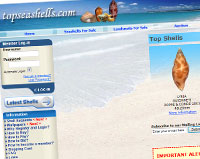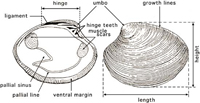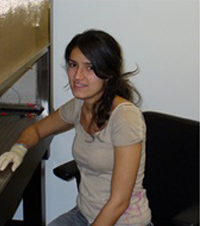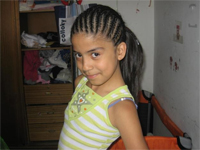Introduction
This project was created in fall 2009, as a requirement for the Information Architecture class, with the instructor Fela Smith.
The analysis is shown in sequence, so that it shows how the idea was developed and being improved along the different phases.
Project Description
Malacology.net will be a tool for scientists, collectors or people interested in the taxonomy of sea shells. It will contain a taxonomy identification key that will allow the users to identify any marine molluscan shell, including those of brackish waters. The site is intended to have a high level of scientific strictness, combined with easy-to-understand language and nice layout.
The web site will be financed through memberships and sponsoring. The service will be available through a membership only. The price will vary depending on the frequency that it will be used. Sponsoring will come from scientific journals and from universities or research institutes that would like to use the site, as well as promote the communications interchange through it.
The primary content of the site will be the section for shell identification which will contain the taxonomical keys and a global distribution map. The purpose is that a person can use the taxonomic tools to find the species name for a shell. At the end of the search, the user will get an species information sheet with taxonomic description, general information about ecology, local and global distribution maps and biogeography. Also it will be offered links to more detailed information about the items mentioned and about the authors that have written about the species.
The secondary sections will be:
Sponsors commercial area.
Basic information about the topic (taxonomy, biogeography, mollusks evolution, etc).
Bibliography: section where users can refer to the publications with links to their web sites or to the content when its access is permitted.
Blog: users will have this space to discuss about taxonomy matters, exchange experiences, post photographs, sell shells or other communications related with the shells.

Malacology is the study of shells.

Phyllonotus duplex
Competitive Analysis
This analysis is based on the comparison of 3 top competitor websites in the subject of mollusks taxonomy. It is presented a description of contents, functionality and usability of each site to finally find which aspects are needed to be kept in mind when designing the malacology.net web site.
After analizing five main parameters in each site, a matrix was built. Click here to see the matrix.
As a final step, to simplify the comparison, a qualification was made, based on a 1-5 scale of good development and design standards for the web, being 5 very high, 4 high, 3 medium, 2 poor and 1 very poor. The results are shown on the table below.
| PROPERTY | manandmollusc.net | marinespecies.org | topseashells.com |
| Content | 2 | 4 | 2 |
| Navigation | 2 | 5 | 3 |
| Functionality | 2 | 3 | 2 |
| Visual Design | 2 | 4 | 3 |
| Use of technology to convey message | 1 | 3 | 2 |
| TOTAL | 9 | 19 | 13 |
The three web sites compared are three different points of view of sea shells on the web. The second was the more competitive with Malacology.net, with 19 points. The navigation is its stronger point, followed by the content and visual design. None of the characteristics of the other sites appeared as competitive with malacology.net.
None of the sites offered taxonomic identification keys, as is the purpose of malacology.net. Even though the second and third offer a species information sheet at the end of the search for a species, with distribution map, none of them is of the quality of the sheets planned on malacology.bet, with printable quality and easy to read layout.
Conclusion
Malacology.net will offer a product that is not offered on the web for mollusks yet. The competitor web sites do not offer the same product and most of them do not have a good design and usability quality. Marinespecies.org is the only one to have as a point of reference for evaluating navigation, content and visual design for the final product of the web site.
Go back to the top
manandmollusc.net

marinespecies.org

topseashells.com
Business Requirements
The website is a new type of web site, that had not existed before. Therefore, the requirements should be collected from a meeting with the stakeholders and interview with users where the users' needs are identified.
In this case, I used my experience as a biologist, and thanks to my BS in Biology thesis, which was about the identification and study of distribution of mollusks in the Utria bay, on the Pacific coast of Colombia. The table below shows the main requirements and a brief description for each one.
The complete matrix can be seen by clicking here.
Taxonomic identification key
The taxonomic identification key will let users find the scientific name of the species they have collected.
Species information sheet (SIS) protocol
Results must be shown on an information sheet containing local and/or global distribution, picture or drawing, systematic description, ecology, biogeography and authors.
Membership
The taxonomic identification and SIS will be available only to members that pay a daily, monthly or annual membership.
Sponsoring
The website will be financed through sponsoring.
Blog
Space where the users can communicate about mollusks, events and commerce of shells.
Go back to the top
Bivalvia morphology.

Taxonomy key process.
Personas & Scenarios
Primary users of the site will be students, teachers and professionals in the marine biology area, who need to make studies and reports with a high level of scientific strictness. They would also like to use the blog to interchange their findings with other students, teachers or professionals. They need to use the web site on a daily year-round basis.
Secondary users will be those that do not need to use the website on a daily basis, but need to keep the membership for sporadic use, maybe for a year, while the project last. They also would like to use the blog to interchange findings and see what other professionals have to say about mollusks.
Complementary users are those that would need the website one time, or two, but not with a high frequency. For instance, tourists that collect shells on a vacation and want to find their scientific names. The personas identified for this project were based on information obtained from marine research institutions web sites and personal experience.
Primary Persona
Name: Marcela Serrano. Age: 22 years. Gender: female. Profession: marine biology student at the National University of Colombia in Santa Marta.
Scenario: the expedition to Malpelo Island has arrived. The students that were on board collected thousands of shells, which were given to Marcela. After organizing them and selecting those that need to be classified, she uses malacology.net to begin the taxonomic identification. For those shells that she could identify through the Taxonomic Identification Keys, she prints out the Species Identification Sheet (SIS) and give to the professor. She remains with those that could not be identified. After checking on the books and confirm that the identity is unknown, she looks on the authors details of the SIS to see where they work. She sends communications to them using the institutional information provided on the web site and also post a comment on the blog, with pictures of the shells. A student form Brasil posts a comment stating that she has a similar shell and give her a possible name for the species which is confirmed by one of the experts from the University of Cuba that answers to her e-mail.
Secondary Persona
Name: Orlando Campos. Age: 35 years. Gender: male. Profession: sales. He works on commission to sell different products, such as shells for collectors.
Scenario: Orlando gets a shell in the market. He is not familiar with its appearance, so he goes to malacology.net and find out is a rare species in high risk of extinction. He prints the SIS for his collection, and post an announcement on the blog about the precious shell.
Complementary Persona
Name: : Manuela DeFrancisco. Age: 10 years. Gender: female. Profession: 5th grade student.
Scenario: Manuela has to make a science project for the school. She wants to present her father's shell collection with their scientific names. With the help of her father she will access the web site and use the taxonomic identification key to find out the names of the shells and also make a book with their species identification sheets.
See the complete Personas & Scenarions description by clicking here.
Go back to the top
Primary persona.

Secondary persona.

Complementary persona.
Prioritization Matrix
1. Species information sheet (SIS) protocol
Is the primary product of the web site. Users will always want a SIS for their shells and that is why it has the top priority.
2. Taxonomic identification key
Even though it was the primary goal for building the web site, not all users will look to use the taxonomic identification keys; some of them will have already the name of the species and will only want to get the SIS. Therefore it is a second place product on the web site.
3. Blog
During the previous analysis it was noticed that the blog is one of the main parts of the web site. It is going to be a useful tool in the future to create networks around the topic of the sea shells.
4. Sponsoring
Sponsoring is important for the business, since is the way that the web site will be financed.
5. Membership
Membership is important because is the way that improvements and expansion of the web site will be financed.
See the complete matrix here.
Go back to the top
Priorization matrix.
Site Map
The map is based on the analysis previously made trough the competitive analysis, business requirements and personas & scenarios. Two small sections were added after careful consideration of its need: Newsletter and Events. The Top category was renamed as NETWORK, and the blog (which was the original category) was included inside.
See the map by clicking here.
Two years after the project definition and information architecture were finished, the project was selected to be part of the portfolio, and the design process began. Many of the section changed in order or priority as the web site grew, as a result of consulting different sources of information and following a redesign process.
See the current Site Map here.
Go back to the top
Site map.
Flow Chart
Five processes are carried out for users access of different features on the web site:
Using the Taxonomic Keys
Getting Species Information Sheets when the user already has the name of the species
Finding pictures of a n specific taxon through the Pictures Archive
Getting information of institutions and/or authors through the Directory
Getting or renewing a membership.
Logging-in
See flow chart here.
Go back to the top
Flow chart.
Wireframes
Wireframes were designed for the four main pages. They show the distribution of sections, and the proportion of information that they should show.
See the wireframes here.
Since most of the basic information had been gathered, the process for the design was easier. First, the design requirements set for the stakeholders since the beginning were considered:
High level of scientific strictness.
Easy-to-understand language.
Nice layout.
The process wiil continue with the selection of the comp by the stakeholders, corrections made by the design team and everything will go to the programmers' hands, who will make the functionality for the internal processes.
Go back to the top
Wireframe.
Design Concept
Two comps were prepared, which were presented for the home page and for a secondary page that was part of the most critical processes on the web site, such as the taxonomic key.
Comp 1
The first design is based on the sea. The main color is blue, titles in white and blue, as well as links. Backgrounds are in blue, white or yellow.
This design was focused on the primary persona. Since is a young marine biology student, the page must have a fresh look but with the clearness and organization that scientists need.
The font used was Corbel which is rounded, clear but with a touch of fun.
Buttons are in 3-D to make them have primacy over any other title on the page.
Comp 2
The second design is based on the shells. The main color is brown, titles in white and brown, as well as links. Backgrounds are in the beige gamma.
This design was focused on the secondary persona. Since is a person interested in business and maybe in science too, the page must have a serious look, be clear and organized, so users will not loose time looking around.
The font used was TW Cen MT which is rounded, clear serious but not old, and it reflects the informational quality of the page.
Navigation location is shown in red, as shown on, to make it more visully relevant on the page.
Go back to the top

